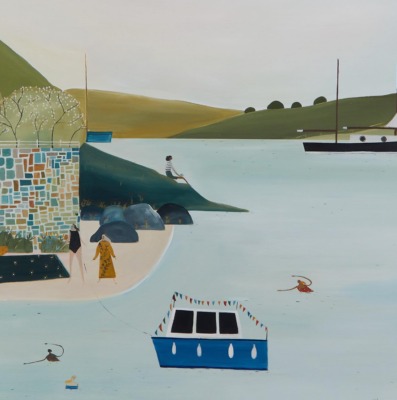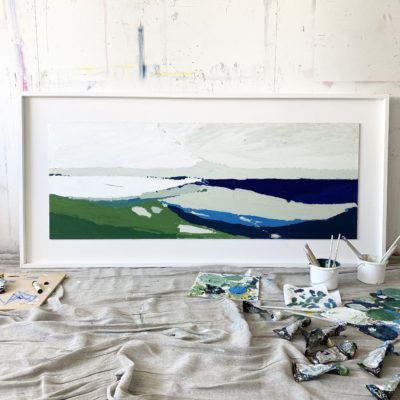This website uses cookies so that we can provide you with the best user experience possible. Cookie information is stored in your browser and performs functions such as recognising you when you return to our website and helping our team to understand which sections of the website you find most interesting and useful.
Course details
Capture the ever changing space where the land meets the sea, where water washes over dark rocks and the tide draws in and out using both acrylics and oils.

How do you capture the essence of the coast; the energy, tension and mystery of two elements meeting? This course teaches you to build free, abstract landscape paintings with sweeping marks and shadowy layers that echo the movement of water over land.
Artist tutor Amy Albright divulges her unique tips and techniques for creating layers of interest. Using both water and oil-based media, these work to build the ethereal sense of the coastline.
Spend time making notes and sketches by the water, absorbed in the constant motion of tumbling waves, fizzing tides and rivers trickling back to the sea. These studies will bring richness and power to your paintings later.
The course introduces you to abstraction in a unique way, using it to evoke both serene calm and intense energy. Look more closely at colour mixing. Learn to build up layers, working wet on wet, adding luminosity and revealing and adding to subsequent layers of paint.
Amy shows you how to create harmony between deeper layers inspired by jagged rocks and glassy glazes that diffuse light on the surface. Oil glazing was particularly favoured by Dutch masters, who used the technique to bring a milky translucence to the skin of portraiture subjects. Amy demonstrates how to use glazing to create the liquid skin of sea lapping the shore.
Full of discovery and revelation, this course presents unique processes and perspective. Capture the entrancing energy of the shoreline with truly inspiring teaching in a spectacular setting.
Day to day plan
This is a rough indication of what to expect over the course. However sometimes the structure of the days may alter depending on the nature of the group and weather.
Day 1
After introducing you to the course, we will take our sketchbooks outside to observe the shore and coastlines. Amy will guide you with some drawing techniques to help loosen up your mark-making.
Back in the studio we will begin creating interesting base layers using expressive painterly techniques, incorporating inks and acrylics with unconventional mark making tools.
Day 2
Spend time looking more closely at colour mixing, particularly using combinations appropriate to our subject – the shoreline. Look at tone, temperature and subtle colour mixing using water based paints.
Later we will then work with oil paints to add glazes, learning to create thin layers of paint to build luminosity and depth. We’ll combine all that we’ve learned and work on a variety of surfaces to start creating multiple pieces.
What will I learn?
- Learn to create exciting experimental paintings that build layers of interest.
- An opportunity to build your confidence using oils, loosen up and widen your painting repertoire.
- Tips on loosening up when drawing the coast, including new techniques to make drawing fun and expressive.
- Learn how to use abstraction when working with landscape to create a painting full of depth and intrigue.
- Technical knowledge of colour mixing to evoke subtle changes in tone and temperature.
Who would this course suit?
If you’re wondering if this course is for you, have a look at Amy’s own work – either on her tutor page or her own website. If you’d like to gain technical insight into combining materials to create intriguing effects, as well as how to have more control in your colour mixing, this course is a wonderful place to learn. It is a fun opportunity for painters interested in the coastline to engage with it in a free and experimental way.
Taught by
What to Bring
Our studios are fully equipped and we provide you with all the materials you need for your course. However, if you have a favourite set of brushes or any specialist materials that you would prefer to use, please bring them with you.
Our studios are fully equipped and we provide you with all the materials you need for your course. However, if you have a favourite set of brushes or any specialist materials that you would prefer to use, please bring them with you.
Timings and Breaks
The first day starts at 10am and finishes at 4.30pm, please aim to arrive ten to fifteen minutes before the start time.
All course days after that start at 9.30am and end at 4pm. There are plenty of nearby places to eat and we will serve tea and coffee at break times during the day.
The first day starts at 10am and finishes at 4.30pm, please aim to arrive ten to fifteen minutes before the start time.
All course days after that start at 9.30am and finish at 4pm and there will be an hour for lunch. There are plenty of nearby places to eat and we will serve tea and coffee at break times during the day.
What our students say
Course was full of exciting new techniques – taught in a relaxed way with plenty of ,materials to work with and on.
Amy is a very effective tutor who gave us students great tips on tools to work with.
I learnt lots of new techniques whilst having the freedom to experiment in my own style.
FAQs
Studio Courses
How can I get help in choosing a course?
Our friendly expert staff are always happy to discuss your needs and our courses in more detail to help you with your decision. Please call us on 01736 797180
How do I get my work home?
Tutors have special techniques for transporting oil paintings and the school has plastic folders available in our shop for £3.50 or do bring a portfolio.
For international students we are happy to arrange transportation of your work back home.
What do I need to bring?
Absolutely nothing! All materials and aprons are provided although some people do like to bring their own set of brushes.
What do I do for lunch?
Courses allow an hour’s break for lunch and there are numerous places nearby or you are welcome to bring a packed lunch into the studio.
What times do courses run?
Most of our courses start at 10am and end at 4.30pm on the first day. Subsequent days we start at 9.30am ending at 4pm.
Weekend Courses run 10am – 4pm on the first day but the final day starts at 9.30 and ends at 3.30 with a short lunch break to enable people to get home that evening.
Do you have to be experienced to come to the School?
The School is a very friendly and welcoming place for all ages and experience. Our drop-in life classes and August half-day workshops are ideal for those wanting to have a go for the first time. Most of our longer courses are also fine for novices.
If any of the courses do need a bit of experience we flag this up in the brochure and on the website.
Booking a Course
How can I reserve a place?
We will hold a provisional reservation for 24 hours if you give us a call whilst you find accommodation. Otherwise please book online or by telephone 01736 797180.
You can reserve a place with a £100 deposit; balance is due 12 weeks before course start date.
About St Ives
Where do I park?
The nearest long stay public car parks are the Island and Barnoon Long Stay Car Park, both a 5 minute walk away. In the peak summer months it may be easier to park at Trenwith Car Park by the leisure centre and walk down into town. If you don’t fancy the walk up the hill at the end of the day there is a shuttle bus which runs from outside the cinema.
How do I get there?
Public Transport: If you are coming from further afield the main train line runs into St Erth which is a 15 min taxi ride away or you can take the St Ives Bay Line which runs approx. every 30 minutes. The School is a 10 minute walk from St Ives station.
Driving: M5 will take you to Exeter where we recommend that you take the A30 across Bodmin Moor and into Cornwall. After passing Hayle, leave the A30 at St Erth roundabout for St Ives. Turn right at the second roundabout. This road will take you through Lelant and Carbis Bay into St Ives.
Where can I stay?
St Ives has a huge selection of hotels, guest houses and self catering accommodation to choose from. Please browse the art holidays St Ives section on our website and give us a call if you would like any help.









